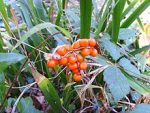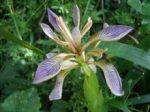 Also known as gladdon, Gladwin iris, and roast-beef plant, this rhizomatous, beardless iris is an evergreen herbaceous perennial native to northern Africa and Europe where it grows in open woods, sea cliffs, and shady places. It is a member of the iris family, Iridaceaea, that also includes gladiolus, crocus, and freesia. Plants grow 1.5 to 2′ tall and have dark green sword-like leaves up to 24″ long. In late spring pale lavender flowers appear on 10-24″ scapes and give way to seedpods that break open in the fall to reveal clusters of bright coral seeds that persist into winter. The seeds are not attractive to birds but the seeds in their pods are very desirable for dried arrangements. Plants are grown primarily for their attractive seed pods and foliage, but the seed pods may not appear until the 2nd or 3rd year. This iris is especially shade tolerant and is a good choice for a shade garden especially among shrubs. The common name, stinking iris and roast-beef plant come from the unpleasant beefy odor of the leaves when bruised. The genus name, Iris, honors the Greek goddess of the rainbow. The specific epithet, foetidissima, is the Latin word meaning very foul smelling and refers to the unpleasant odor of the bruised leaves.
Also known as gladdon, Gladwin iris, and roast-beef plant, this rhizomatous, beardless iris is an evergreen herbaceous perennial native to northern Africa and Europe where it grows in open woods, sea cliffs, and shady places. It is a member of the iris family, Iridaceaea, that also includes gladiolus, crocus, and freesia. Plants grow 1.5 to 2′ tall and have dark green sword-like leaves up to 24″ long. In late spring pale lavender flowers appear on 10-24″ scapes and give way to seedpods that break open in the fall to reveal clusters of bright coral seeds that persist into winter. The seeds are not attractive to birds but the seeds in their pods are very desirable for dried arrangements. Plants are grown primarily for their attractive seed pods and foliage, but the seed pods may not appear until the 2nd or 3rd year. This iris is especially shade tolerant and is a good choice for a shade garden especially among shrubs. The common name, stinking iris and roast-beef plant come from the unpleasant beefy odor of the leaves when bruised. The genus name, Iris, honors the Greek goddess of the rainbow. The specific epithet, foetidissima, is the Latin word meaning very foul smelling and refers to the unpleasant odor of the bruised leaves.
 Type: Evergreen herbaceous perennial
Type: Evergreen herbaceous perennial
Bloom: Pale lavender in late spring
Size: 1.5-2′ H x 1-1.5′ W
Light: Full sun to part shade
Soil: Average, moderately moist, well-drained; drought tolerant
Hardiness: Zones 6-9
Care: Low maintenance
Pests and Diseases: None of significance
Propagation: Seed, division
Companion Plants: Roses, Corsican hellebore, Mediterranean spurge, Mexican orange blossom
Outstanding Selection: ‘Varigata’ (yellow variegated leaves)
Photo Credits: Wikipedia